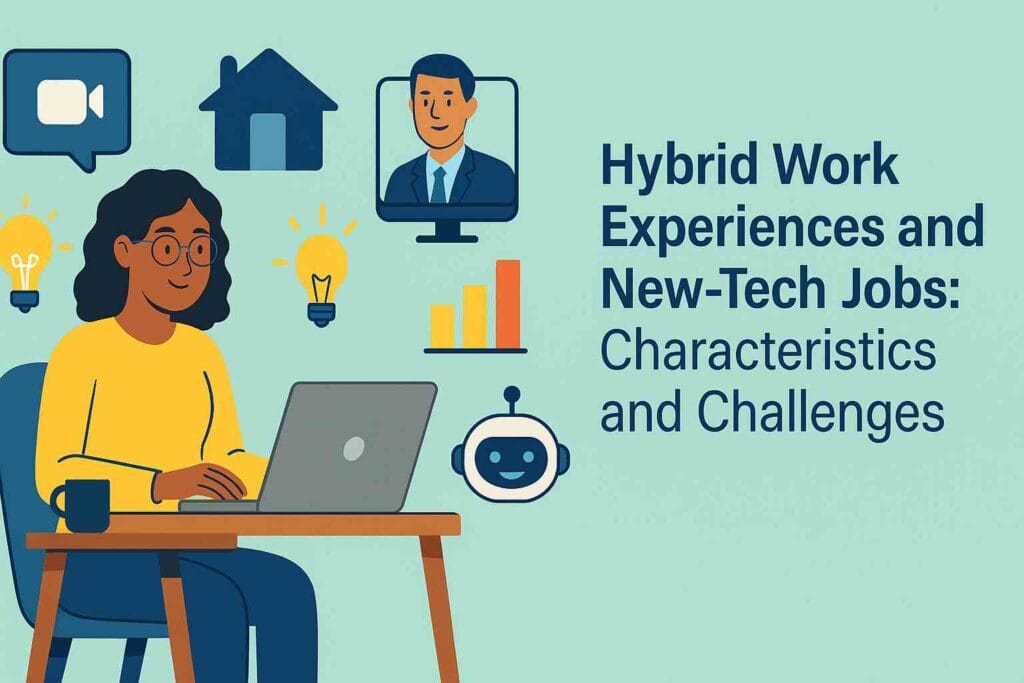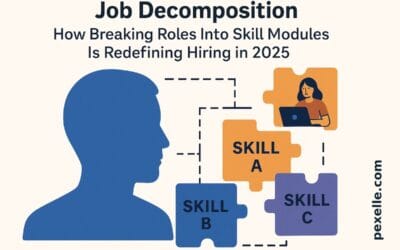Hybrid Work Experiences and New-Tech Jobs: Characteristics and Challenges

The modern workforce has undergone a dramatic transformation in recent years, with hybrid work environments and new-tech jobs taking center stage. This shift, accelerated by the global pandemic, has reshaped how we work, collaborate, and interact with technology. Hybrid work, in particular, refers to a flexible work model that combines remote and in-office work, offering employees more autonomy over their work locations. Meanwhile, the rise of new-tech jobs is driven by advancements in fields like artificial intelligence, blockchain, data science, and cybersecurity. Together, these trends present both exciting opportunities and significant challenges.
Characteristics of Hybrid Work Environments
- Flexibility: One of the defining characteristics of hybrid work is flexibility. Employees have the ability to choose where they work, balancing time between home and the office. This flexibility can lead to higher job satisfaction, increased productivity, and a better work-life balance.
- Technology-Driven: Hybrid work heavily relies on technology to bridge the gap between remote and in-office work. Tools like video conferencing software (e.g., Zoom, Microsoft Teams), project management platforms (e.g., Trello, Asana), and cloud-based document sharing (e.g., Google Drive, Dropbox) are essential for facilitating communication and collaboration.
- Autonomy and Accountability: Hybrid work demands greater autonomy from employees. Without constant supervision, workers are expected to manage their time effectively and produce results. This can be empowering, but it also requires individuals to develop strong self-discipline and accountability.
- Hybrid Communication: Communication in a hybrid work environment can be a challenge. Employees working remotely may miss out on spontaneous discussions, impromptu meetings, and team-building opportunities that happen in physical offices. Effective communication strategies and tools are vital to ensure that everyone stays connected, informed, and engaged.
New-Tech Jobs: The Future of Work
The rapid evolution of technology has given rise to new job roles and industries, many of which didn’t exist a decade ago. These new-tech jobs are typically centered around the application of advanced technologies such as AI, machine learning, and blockchain. Here are some key characteristics of new-tech jobs:
- Innovation and Creativity: New-tech jobs often involve problem-solving and innovation. Roles like AI engineers, blockchain developers, and data scientists require creative thinking to develop cutting-edge solutions. These jobs can be highly rewarding, as they offer the chance to contribute to the future of technology.
- Skills-Based: Unlike traditional jobs, many new-tech roles prioritize skills and expertise over formal education. Workers in these fields often have specialized knowledge gained through hands-on experience, certifications, or coding boot camps rather than traditional degree programs.
- Dynamic and Evolving: Technology evolves at a rapid pace, and so do new-tech jobs. Professionals in these fields need to continually update their skills to stay relevant. For example, as AI and machine learning algorithms evolve, so too do the tools and techniques used to build them.
- Collaboration with AI and Automation: In many new-tech jobs, humans work alongside AI and automation. While some fear that these technologies will replace jobs, in reality, they often enhance human capabilities, allowing workers to focus on higher-level decision-making, creativity, and strategy.
Challenges of Hybrid Work and New-Tech Jobs
While hybrid work and new-tech jobs offer numerous benefits, they also present certain challenges that organizations and individuals must address.
- Work-Life Boundaries: One of the most significant challenges of hybrid work is maintaining clear boundaries between work and personal life. Without a clear separation, employees may struggle with burnout and work-related stress, as the lines between work and leisure become increasingly blurred.
- Digital Fatigue: With hybrid work often relying on digital tools for communication and collaboration, employees may experience digital fatigue. Extended hours of screen time, coupled with virtual meetings, can lead to burnout and decreased productivity. It’s essential to encourage regular breaks and time away from screens to mitigate this effect.
- Inequity in Access to Resources: Not all employees have access to the same resources when working remotely. For example, some may have a dedicated home office, while others may work from a less-than-ideal environment. Employers must consider equitable access to resources, such as high-speed internet, ergonomic workspaces, and proper equipment, to ensure fairness across the workforce.
- Talent Shortage: As new-tech jobs continue to emerge, the demand for skilled professionals in fields like AI, blockchain, and cybersecurity has outpaced the supply. This talent shortage creates competition among companies, often leading to higher salaries and greater expectations for job candidates.
- Cybersecurity Risks: Remote work increases the exposure to cybersecurity threats, especially if employees are using personal devices or unsecured networks. Employers must invest in robust cybersecurity measures, such as encrypted communication tools, VPNs, and regular security training to protect sensitive company data.
- Team Cohesion and Culture: Hybrid work models can make it difficult to foster a strong team culture. Without regular in-person interactions, it may be harder to build trust, collaboration, and camaraderie among team members. Employers must be intentional about creating opportunities for social connection, whether through virtual events or periodic in-person meetings.
Conclusion
Hybrid work environments and new-tech jobs are shaping the future of the workforce, offering numerous benefits but also presenting unique challenges. To successfully navigate this evolving landscape, companies must invest in the right technologies, foster a culture of trust and accountability, and provide support for employees to maintain a healthy work-life balance. By addressing the challenges head-on, organizations can leverage the full potential of hybrid work and new-tech jobs to drive innovation, enhance productivity, and create a more flexible and inclusive work environment.
Source : Medium.com




